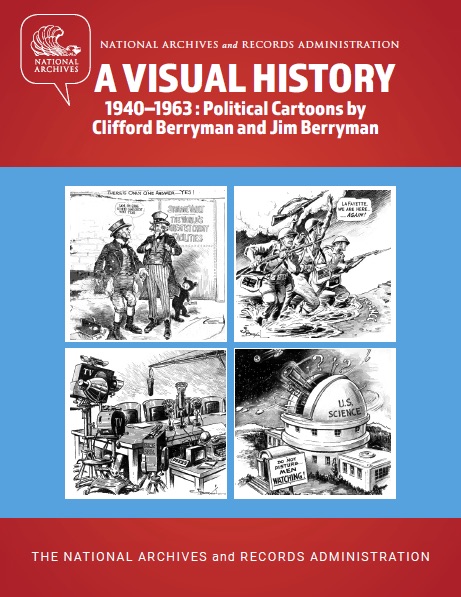
Reviewing Major Topics in U.S. History from 1940 – 1963 with Political Cartoons
Summary
In this lesson students will analyze political cartoons by Clifford and Jim Berryman to review seven major topics in U.S. History from 1940 to 1963.
Rationale
Students develop critical thinking skills by analyzing political cartoons representing major issues of World War II, as well as the post-war issues of the Cold War, the Rise of Science and Technology, and Civil Rights.
Guiding Question
How did the issues reflected in these cartoons change America?
Materials
A Visual History, 1940-1963: Political Cartoons by Clifford Berryman and Jim Berryman eBook
Graphic Organizers
21 Primary Source Sheets
Reflection Questions
 Featured Document
Featured Document
A Visual History, 1940–1963: Political Cartoons by Clifford Berryman and Jim Berryman presents 70 political cartoons that invite students to explore American history from the early years of World War II to the civil rights movement. These images, by father-and-son cartoonists Clifford Berryman and Jim Berryman, highlight many significant topics, including WWII and its impact, the Cold War, the space race, the nuclear arms race, and the struggle for school desegregation. This eBook presents the artists’ perspectives on the events, people, and institutions that shaped this tumultuous era of American history.
Recommended Grade Levels
7 - 12
Courses
U.S. History, etc.
Topics
Political cartoons, U.S. foreign policy, World War II, The Cold War, Science and Technology, Civil Rights
Time Required
Two forty-five minute class periods.
Learning Activities
Preparing the Materials
- Print for each student copies of the Graphic Organizer pages and the Reflection Question Worksheet.
- Establish seven stations, one for each page of the Graphic Organizer.
- Make one additional copy of the Graphic Organizer to provide one page for each station.
- Make one copy of the Primary Source Sheets and cut along the dotted lines of each sheet. Keep each cartoon, caption, and description together with a paperclip.
- Place a copy of one Graphic Organizer and the related cut-outs at each station. Mix up the cartoons, captions, and descriptions at the station so that students must match the ideas together.
Classroom Activity
- Divide the students into seven groups.
- Carousel the groups through the seven stations.
- Provide each group with enough time at each station for students to:
- Match each political cartoon to the reading and summarize the text on their individual Graphic Organizer.
- Match the appropriate caption to the political cartoon (the reading will help provide scaffolded support) and write the caption on their individual Graphic Organizer.
- Explain how the cartoon matches the caption on their individual Graphic Organizer.
Reflection Activity
- When the students have completed their work at all seven stations, instruct each student to complete the Reflection Questions Worksheet and prepare to share their responses with the full class.
- Have a whole group discussion of the Reflection Questions.
Additional Resources
Congress Represented in Political Cartoons - Students analyze political cartoons drawn between 1898 and 1948 to learn about Congress and its constitutional role in government.
Constitution Scavenger Hunt with Political Cartoons - Students analyze political cartoons to learn about the outline and structure of the Constitution, as well as the content of many of its clauses.
Reviewing Big Civics Ideas through Political Cartoons - Students analyze political cartoons drawn by Clifford K. Berryman between 1898 and 1948 to learn about the Constitution and constitutional institutions of government and politics.
Studying U.S. Foreign Policy through Political Cartoons, 1898 - 1940 - Students analyze political cartoons drawn by Clifford K. Berryman between 1898 and 1948 to learn about topics and major events in U.S. foreign policy.
Studying 4 Major Issues of the Post-World War I and 1920s Era with Primary Sources - Students analyze primary source documents from the National Archives and political cartoons drawn by Clifford K. Berryman to learn about topics and major events in U.S. History from 1919 - 1930.
From the Cold War to Camp David: Reviewing U.S. Foreign Policy in Post-World War II Era (1948 – 1979) - Students will analyze primary source documents to review four major topics in U.S. History from 1948 - 1979.
If you have problems viewing this page, please contact legislative.archives@nara.gov.
PDF files require the free Adobe Reader.
More information on Adobe Acrobat PDF files is available on our Accessibility page.